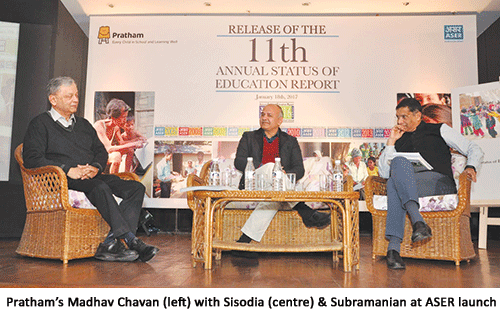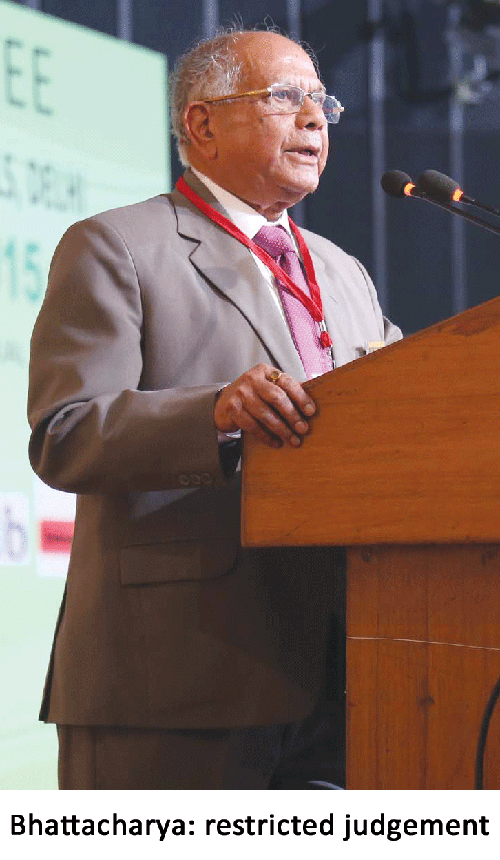 The Annual Status of Education Report (ASER) 2016 of the Mumbai-based Pratham Education Foundation (estb.1994) — published after skipping a year — indicates that the continuous slide in primary education in rural India seems to have been halted with children’s reading and arithmetic capability improving marginally. It also reports improved infrastructure, particularly in toilets and drinking water availability. Interestingly, the report released on January 18, says there was no significant increase in private school enrolments between 2014 and 2016.
The Annual Status of Education Report (ASER) 2016 of the Mumbai-based Pratham Education Foundation (estb.1994) — published after skipping a year — indicates that the continuous slide in primary education in rural India seems to have been halted with children’s reading and arithmetic capability improving marginally. It also reports improved infrastructure, particularly in toilets and drinking water availability. Interestingly, the report released on January 18, says there was no significant increase in private school enrolments between 2014 and 2016.
The under-appreciated (not by EducationWorld) annual ASER report involves resource mobilisation on a massive scale. The 2016 survey commenced last September and involved networking with 500 local organisations and mobilisation of 25,000 volunteers (mainly college students) who fanned out across 589 rural districts to test the unprepared literacy and numeracy capability of 562,305 children (in the age group 3-16) of 350,232 households in 17,473 rural habitations, making it the largest learning assessment survey countrywide.
Among the positives according to ASER 2016, is a marginal improvement in reading and comprehension (vernacular languages) in rural (mainly government) schools. “Nationally, the proportion of children in standard II who are able to read std I level texts has risen slightly from 40.2 percent in 2014 to 42.55 percent in 2016,” says the report, adding that reading capability of class VIII children hasn’t improved at all except marginally in the states of Manipur, Rajasthan, Maharashtra and Tamil Nadu.
Numeracy learning outcomes show an upward trend for the first time since 2010. The percentage of class III children who can do two-digit subtraction sums has increased to 27.7 percent from 25.4 percent in 2014. However, the capability of class VIII students to do division sums has continued to drop, a trend observed since 2010.
Similarly, the ability of lower primary children to read English has remained unchanged, and has changed for worse in upper primary grades. “In 2016, the percentage of those who can read words has declined with roughly 60 percent able to explain the meanings of the words they read,” write the authors of the report. Although ASER 2016 reports marginally better learning outcomes as improvements, it’s pertinent to note that with barely a third of pupils are able to attain acceptable reading and numeracy capability and overall learning outcomes in rural primaries continue to be pathetic.
Despite this, the proportion of children enrolled in private schools has remained unchanged at 30.5 percent in 2016, as compared to 30.8 percent in 2014. In general, although the authors of ASER 2016 try hard to find a silver lining to the huge cloud hanging over Indian education, the bigger picture is depressing. According to Rukmini Banerji, CEO of Pratham, it’s “something important for all of us to be worried about.”
Delhi state’s deputy chief and education minister, Manish Sisodia, ascribes continuously poor learning outcomes in primary schools countrywide to official apathy and inertia. “Over 90 percent of government officials don’t have a dream for education in the country. Governments at the Centre and in the states need to change their mindsets. Our children, teachers, classrooms and government officials have become victims of examination fever and have lost direction,” says Sisodia.
Likewise, Arvind Subramanian, chief economic advisor of the BJP-led NDA government at the Centre, is mystified by the weak demand for better school education in rural India. “There’s very little public pressure on political parties to move education higher on their election manifestos. Unless there’s pressure from the electorate for education reforms, it won’t happen,” observed Subramanian in a ASER 2016 post-release panel discussion held at Delhi’s India International Centre.
Autar Nehru (Delhi)
Partial victory
 The long-pending issue of whether the Delhi state government can regulate tuition fees charged by private unaided (financially independent) schools which had been allotted land at concessional prices by the Delhi Development Authority — the civic planning unit of the state government — decades ago, has been resolved.
The long-pending issue of whether the Delhi state government can regulate tuition fees charged by private unaided (financially independent) schools which had been allotted land at concessional prices by the Delhi Development Authority — the civic planning unit of the state government — decades ago, has been resolved.
Upholding the verdict of the Delhi high court in Justice for All vs. Govt of NCT of Delhi & Ors, on January 23 the Supreme Court held that private schools in this category need to obtain Delhi government’s approval before raising tuition fees.
“The schools are bound by the lease agreement with the DDA... if the conditions say you need permission, then you have to take it… ,” opined a three-judge apex court bench, dismissing the appeal of the Action Committee for Unaided Recognised Private Schools (ACURPS, estb.1997), an umbrella organisation of six associations of private schools in Delhi NCT (national capital territory) which appealed the high court judgement of January 19, 2016. Among Delhi state’s 400 private schools hit by the judgement are the top-ranked Delhi Public School, R.K. Puram; Modern School, Barakhamba Road; Don Bosco, Alaknanda; Springdales, Pusa Road and Vasant Valley.
“Private unaided schools don’t face any competition from government schools and hence taking advantage of this situation, they have been hiking their fees unchecked. Parents are left with no choice but to pay their unaffordable prices for quality education. Now that will not be the case,” says Kagesh Jha, Delhi-based activist lawyer and founder-president of Justice for All, the victorious petitioner in this case.
However, it’s pertinent to note that the apex court’s final judgement is based on the law of contract. It hasn’t addressed the larger issue of whether the Delhi state government is constitutionally empowered to regulate the tuition fees of all private schools.
Under the Delhi Development Act, 1955, some private school promoters were allotted DDA land under the Delhi Master Plan 2021 at concessional rates for the convenience of citizens who bought housing plots in the authority’s planned settlements. Therefore, the contention of the state government is that while cost components such as learning/teaching infrastructure, teachers’ salaries and overhead costs can be built into tuition fees, bus charges to ferry students from across the city, fees paid to guest celebrities for school events etc, cannot be factored in.
The counter-argument of private school managements is that all land allotment letters don’t contain this condition. Moreover, several Supreme Court judgements, especially the apex court’s 11-judge verdict in T.M.A. Pai Foundation & Ors vs. State of Karnataka (2002), confers full autonomy on private independent schools to formulate their own admission processes and levy reasonable tuition fees. Therefore, the Supreme Court’s January 23 verdict is restricted to the 400 private unaided schools which have received land grants at concessional prices. However, the AAP government of Delhi NCT/state has drafted the Delhi Schools (Verification of Accounts and Refund of Excess Fees) Bill 2015 and the Delhi School Education Act & Rules 1973 (Amendment) Bill 2015 (awaiting assent of the President) which authorises it to regulate tuition fees levied by all 1,800 private schools in Delhi NCT.
“The ambit of the January 23 judgement is restricted to private schools which have received DDA land grants at concessional prices. Therefore, schools which haven’t been allotted concessional land are not bound by this judgement. As per the court’s judgement in the T.M.A. Pai Case, we have full freedom to administer our institutions and levy reasonable tuition fees. As and when the two pending Bills are enacted into law, we will challenge their constitutionality,” says S.K. Bhattacharya, president of ACURPS.
Even as the state government, NGOs and private school associations of Delhi continue their battles in the courts, 1,977 municipal and state government schools of Delhi NCT remain severely neglected. In spite of an unprecedented Rs.10,690 crore budgetary outlay for 2016-17 for education of the Aam Aadmi Party, which has been ruling the national capital for two years, its promise of improving education in government schools remain on paper. Curiously, its conspicuous failure to improve state government schools has not deterred the AAP government from attempting to regulate the national capital’s much maligned private schools, most of whom despite their alleged profiteering, have long admission waiting lists.
Swati Roy (Delhi)